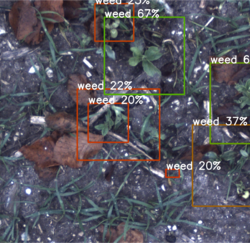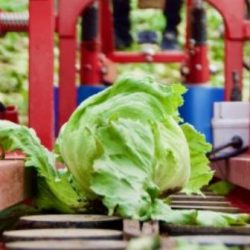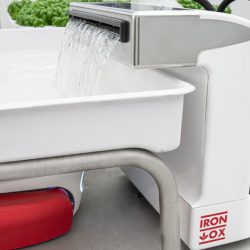
Your next salad can be grown by a robot.
- 247
California startup FarmWise says robotics and machine learning will make crops more delicious and healthier.
FarmWise’s artificial intelligence-powered robots autonomously grow plants and scout for weeds.
At first glance, the plants look no different from other crops typical of California’s Salinas Valley, often called the “American salad bowl”. All you can see is a row of lettuce, broccoli and cauliflower stretching to the horizon. But then the big orange robots appear.
The machines are on a “search and destroy” mission. Their objective? Weeds. Equipped with tractor-like wheels, numerous cameras and environmental sensors, they autonomously move up and down the rows of crops, hunting for any leafy-green invaders. Instead of spraying herbicides, they deploy a retractable hoe that quickly and accurately kills weeds.
The robots belong to FarmWise, a San Francisco startup that aims to make agriculture more sustainable and refined through robotics and artificial intelligence. The company has raised $14.5 million in a recent round of funding and plans to deploy its first commercial fleet of robots in 2020, with more than 10 machines serving farmers in the Salinas Valley.
Weeding Farm Robots
FarmWise says that while its robots are currently optimized for weeding, future plans will do much more. “Our goal is to become a universal farming platform,” says co-founder and CEO Sébastien Boyer. “We want to automate pretty much every task from sowing to harvesting.”
Boyer envisions robots collecting vast amounts of data, including detailed images of plants and parameters that affect their health, such as temperature, humidity and soil conditions. But it’s what the robots will do with the data that really makes them remarkable. They use machine learning to identify each plant individually, determine whether it is thriving and intervene accordingly. Thanks to these artificial intelligence-powered robots, each broccoli stem gets the attention it needs to produce the best broccoli possible.
Automation is not new to agriculture. Harvesters on wheels are becoming more autonomous, and farmers have long flown drones to keep an overhead eye on their crops. Robots designed to pick fruit and vegetables – apples, peppers, strawberries, tomatoes, grapes, cucumbers, asparagus – are also under development. Recently, several robotics companies have drawn attention to how these precision farming techniques can improve crop quality or yields.

Farming robots are still “very much an emerging market”, says Rian Whitton, senior analyst at ABI Research in London, but it will “expand significantly over the next 10 years”. The ABI predicts that annual global shipments of mobile robots for agriculture will exceed 100,000 units by 2030, 100 times the number deployed today.
This is still a small number compared to the millions of tractors and other farm vehicles sold each year, but Whitton notes that demand for automation is likely to accelerate due to labor shortages in many parts of the world.
FarmWise plans to deploy its first commercial robot fleet in California’s Salinas Valley.
FarmWise says it has worked closely with farmers to understand their needs and develop its robots based on their feedback.
How are these Farm Robots made?
First, the sensor system captures images and other relevant data about the plants, and stores this information on both on-board computers and cloud servers.
The second step is the decision-making process, where special deep learning algorithms analyze the data. There is an algorithm to detect the plants in the image, and the robots combine this output with GPS and other location data to accurately identify each plant. Another algorithm is trained to decide whether a plant is, say, a head of lettuce or a weed.
The final step is the physical action the machines perform on the plants – controlling the weed hoe, for example.
Boyer says the robots complete the three steps in less than a second. So far, FarmWise says its robots have removed weeds from more than 10 million plants.
Whitton, an analyst at ABI, says it makes sense to focus on weed control as an initial application. “There’s potentially billions of dollars to be saved by using less pesticides, so it’s the fashionable use case,” he says. But, he adds, the business success of agricultural automation startups depends on whether they can expand their services to handle additional agricultural tasks and operate in different regions and climates
FarmWise already has a growing number of competitors. German conglomerate Robert Bosch, Deepfield Robotics is also testing a standalone vehicle




